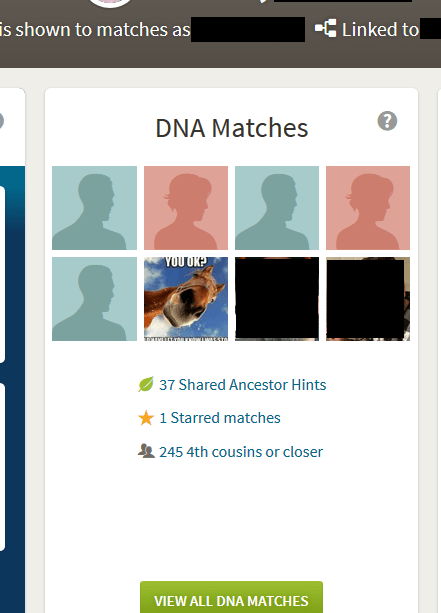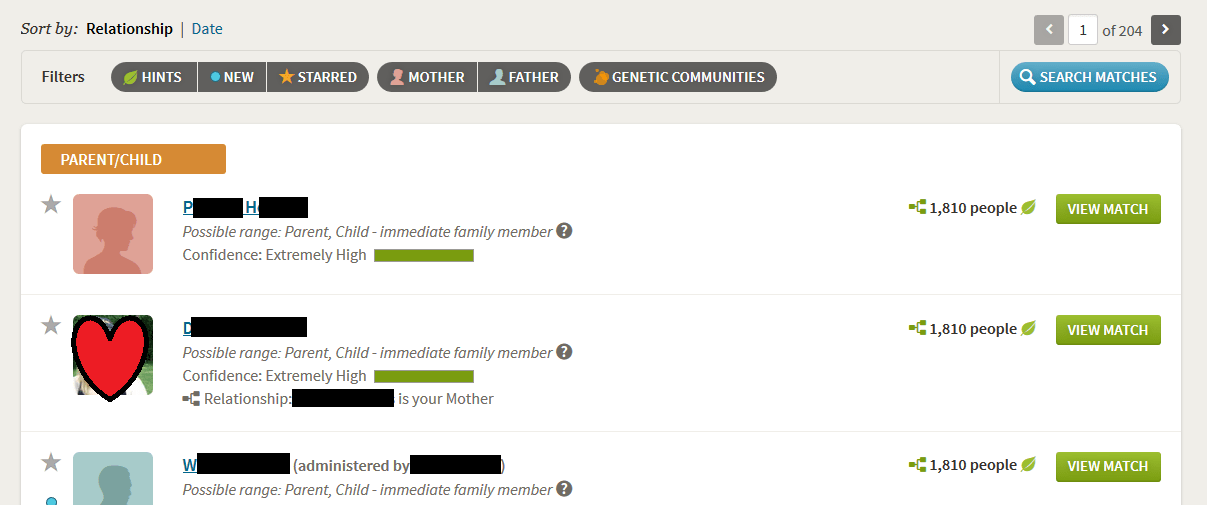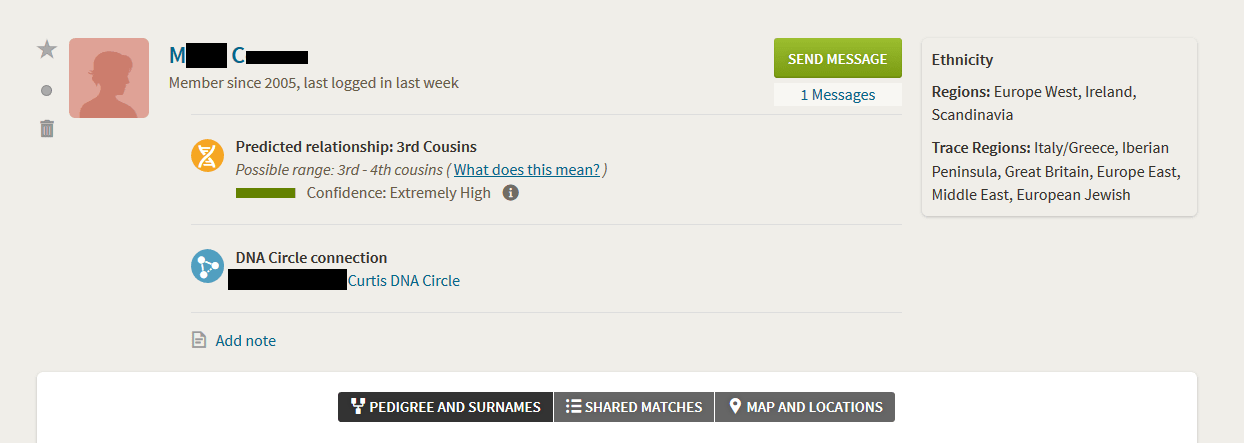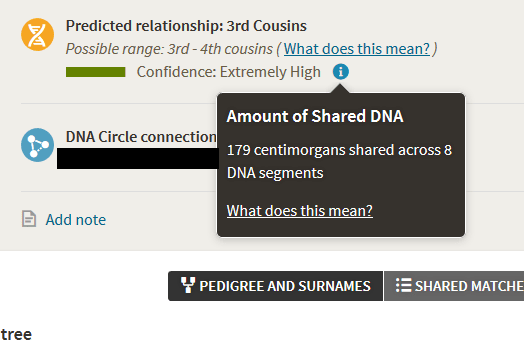In the first post about how to understand your Ancestry DNA results, I discussed how to understand your ethnicity results. In this post, we will talk about the really, super cool part: finding new family members and tracing your family tree.
DNA matches are my favorite part of my DNA results. I love my DNA match list, and I hope that after reading this post, you understand how much you can really get from your Ancestry DNA results.
How to access your Ancestry DNA matches
When you log into Ancestry, click on the "DNA" tab. After the page loads, scroll down just a little until you see a section that looks something like this:

You can find all of your DNA matches in the middle section. Click the "View all DNA matches" button to pull up your list. The screenshot above is from my results. It shows me that I have 245 matches that are estimated to be at a 4th cousin level or closer.
A year and a half after I originally wrote this post, I have 458 DNA matches that match me at a 4th cousin level or closer. My DNA match list is a gift that keeps on giving 🙂
Don't worry if your number is a smaller number - you will still have tons of more distant cousins that you can find to help you with your family/ancestry search. Plus, since Ancestry DNA continues to add new people to your match list as more people do DNA tests, you will find that you'll get more close matches over time.
For example, when my husband first took his test, he only had 2-3 4th cousin or closer matches. He now has 20! (Update: A year and a half later, he now has more than 50! Find out why you don't have more DNA matches)
Once your "cousin matches" load - a lot of us in the DNA genealogy circle just call them all cousins - you will see that everyone has been sorted and placed into groups. The matches are also listed in order of the amount of DNA that they share with you and estimated closeness of your relationship.
I also put a giant heart instead of their profile picture to protect their privacy, and because I love all of my matches! They are, after all, family.
Let's take a look at my results. I always try to protect the privacy of my "matches" by blanking out their names, but it should still help you.

This is what my match list looks like now. The first person listed is my daughter, the second is my mother, and the third is my father. My list looks like this now, but when I first tested, I didn't have nearly as many matches.
I had my parents do the DNA test to help with my research. I know that not everyone is lucky enough to still have their parents living and willing/able to do this test, but it is very helpful and wonderful if they can do it.
You can see under where my mother shows up (the second person in the list). It clearly lists that she is my mother. It says the same thing for my father. It says the same thing on my daughter's account when my name is on her list. It says very clearly that I am her mother.
More distant relationships, even close family, get a little more complicated. Ancestry's computer software analyzes how much DNA you share with your matches, and then puts them in categories based on those results.
For example, a first cousin and a half-aunt share roughly the same amount of DNA, so Ancestry just puts them both in the same group. It is then up to you to figure out who exactly they are - a first cousin or a half-aunt.
(If you are wondering what a half-aunt is, it is an aunt who is the child of only one of YOUR biological grandparents. In other words, a half-sibling to one of your parents. You will share 50% less DNA with this half-sibling of your parent than you would with a full aunt.)
What you can learn about your Ancestry DNA matches for free (without subscription)
- There is a lot of information that you can learn about your DNA matches for free, without having a subscription:
- Their name, if they use it as their Ancestry username
- How much DNA they share with you (how many centimorgans)
- Ancestry's software's prediction of your relationship (usually a VERY loose estimate)
- Their ethnicity regions
- DNA matches that you and the match have in common - "Shared Matches"
- You can message your matches directly from the "View Match" screen.
- Whether you share a DNA Circle in common
For example, take a peek at this screenshot of one of my cousin matches. Her grandparents are my great-great-great grandparents. This makes her my first cousin three-times removed. If you are wondering how in the world this is possible, people live a long time in my family. Her parents were born in the 1880s!
And she lived long enough to take a DNA test in 2016. It's so incredible to me.

In order to learn how many centimorgans we share, I have to click on that little "i" icon where it says "Confidence: Extremely High". If you do that, you will see a little box pop up that looks like this:

Notice that Ancestry predicts that we are in the 3rd to 4th cousin range, when we are actually first-cousins three times-removed. My great-grandfather was her first cousin. This just shows that you need to view your matches with an open mind and take Ancestry's estimates with a grain of salt.
Otherwise, you might miss the chance to make important connections.
What do you need to have an Ancestry subscription to access in your DNA results
Even though you paid Ancestry DNA to do the DNA test, they are still a for-profit corporation and of course, there is a catch. If you want to have access to your family matches' family trees (assuming they have one online), you will need to have a subscription.
Fortunately, it is not very expensive and you can even get a free trial.
Tip: An Ancestry subscription is useful for seeing the family trees of your DNA matches and building a family tree using records, documents, and photographs available on the site.
Pro tip: A subscription will also allow you access to the messaging system on the whole site and access to tons of great documents and records.
For those of you who have a subscription, when you click on "View Match" beside anyone's name on your list, it will show you several generations of their family tree. This is one of the most valuable aspects of doing a DNA test with Ancestry, since they have the largest DNA test database and the added benefit of having millions of family trees and many that are connected to DNA test results.
How to get the most from your Ancestry DNA results
The best way to really learn the most you can from your DNA test is to start researching your family tree. I would recommend building a tree on Ancestry and attaching your DNA results to it. You don't need to have a subscription on Ancestry to build a tree.
Once you build you tree and attach it to your results, you'll see great things like "Shared Ancestor Hints" and maybe even "DNA Circles" appear in your results.
If you would prefer to do your research on your family tree on a different website, you might be interested in my post about family tree research where I discuss free and paid websites for finding family tree records.
Conclusion
So that is about it for a basic overview of how to understand your results. Of course, you can get very deep into each cousin match and all the nuanced details. I'll make plenty more posts about these different topics.
Have you found anything interesting or confusing in your matches? I'd love to see if I can help you figure things out - ask me in the comments!


Paul
Thursday 28th of September 2023
Hi, I need some help, understanding my results,
First i recently found out my father wasn't my father. But the tricky part is this, The person some people are calming is my father, I've link to his sister on ancestry dna, were im not 100% convince is my aunt,
- Aunt ("Fathers" - Sister) Shared DNA: 2,270 cM across 49 segments Unweighted shared DNA: 2,270 cM Longest segment: 125 cM
75% grandparent grandchild half sibling aunt/uncle niece/nephew
25% sibling
Son to the "Aunt" -
Shared DNA: 1,011 cM across 41 segments Unweighted shared DNA: 1,011 cM Longest segment: 62 cM
99% 1st cousin great-grandparent great-grandchild grandaunt/granduncle grandniece/grandnephew half aunt/uncle half niece/nephew
<1% grandparent grandchild half sibling aunt/uncle niece/nephew
- Half brother ("Fathers" - son) Shared DNA: 1,607 cM across 41 segments Unweighted shared DNA: 1,607 cM Longest segment: 125 cM
99% grandparent grandchild half sibling aunt/uncle niece/nephew
<1% 1st cousin great-grandparent great-grandchild grandaunt/granduncle grandniece/grandnephew half aunt/uncle half niece/nephew
But then on my Mother side, i link to my sister,
Shared DNA: 1,684 cM across 41 segments Unweighted shared DNA: 1,684 cM Longest segment: 125 cM
100% grandparent grandchild half sibling aunt/uncle niece/nephew
Thank you
David curran
Friday 16th of September 2022
I can’t seem to find any thing that I’m looking for even though I have paid for ancestry and my heritage
Florence Marie
Tuesday 24th of May 2022
I have two DNA match cousins that I cannot find how we are related. The one does not have knowledge of who who father is, the other was given up for adoption. I'm struggling to find how to keep searching to learn the connections. They each have higher cM numbers than some of the 3-4th cousins I know. I'm old enough to be their grandmother, so with my parents gone and theirs unknown I am lost. Also how can 3 different websites list my ethnicity so differently. I have Ancestry.com, 23&Me, and Heritage.
Corri
Wednesday 9th of March 2022
Hi! I am trying to find good sources of information on how best to interpret the Ancestry DNA results.
I am trying to help a lady who was adopted. She has found her father’s line and even matched to her father’s sister. She is in constant contact with her aunt & 3 half siblings that she discovered she had.
I am now trying to help her figure out who her mom is. The DNA results break down into 3 basic groups based on matches in common. 1 is her father’s line. I’m thinking the other 2 lines, who apparently have no common matches with the other two, are related to her mom. My initial guess is her mother’s maternal line & her mother’s paternal line. She has 1st-2nd Cousin matches in both lines, and I’m working on family trees for both going back 2 generations from the identified 1-2 cousin.
Again, if you know of any good articles that would help me untangle the mess more quickly would be greatly appreciated!
Thanks- Corri
Mercedes
Thursday 17th of March 2022
Hi Corri, Have you heard of the Leeds Method? This might help you out: https://whoareyoumadeof.com/blog/leeds-method-of-dna-analysis/ Good luck to you! Mercedes
Harold Ray
Friday 26th of February 2021
My DNA results show that I am a product of someone other than who I thought was my father. On discussing this with a relative I found out who he was. Then I did further research into 4th to 6th cousins and found DNA matches to people in both sides of who I always thought was my father. How does that happen?
Mercedes
Friday 26th of February 2021
Hi Harold, I'm very sorry to her that your DNA results revealed unexpected information. It is possible that these distant (4th-6th cousin) DNA matches that you have identified are related to him in a different way than they are related to you. For example, someone could be related to you through one fifth great-grandparent and related to him through a different fifth great-grandparent (or other relative). Have you been able to work out how those distant cousins are related to you? That would be the first step I would take in trying to figure this out. I hope that this helps you! Sincerely, Mercedes